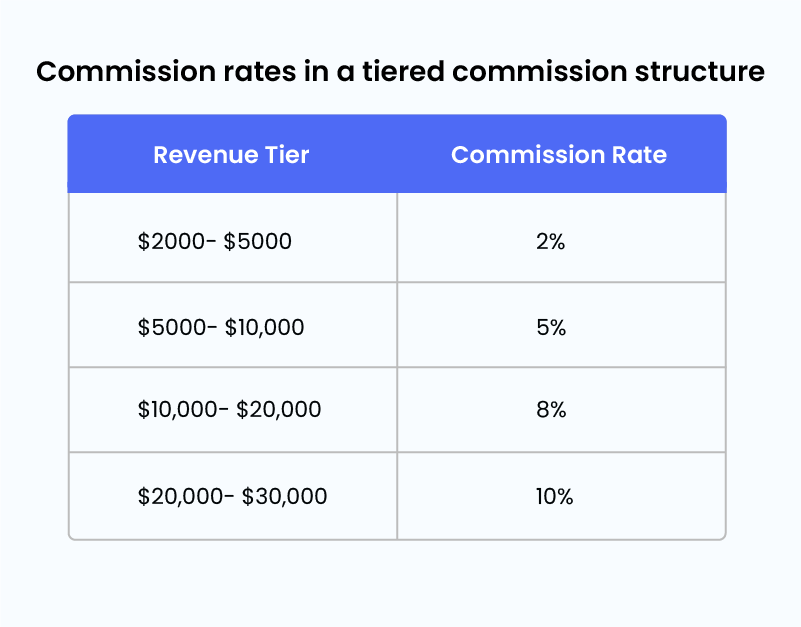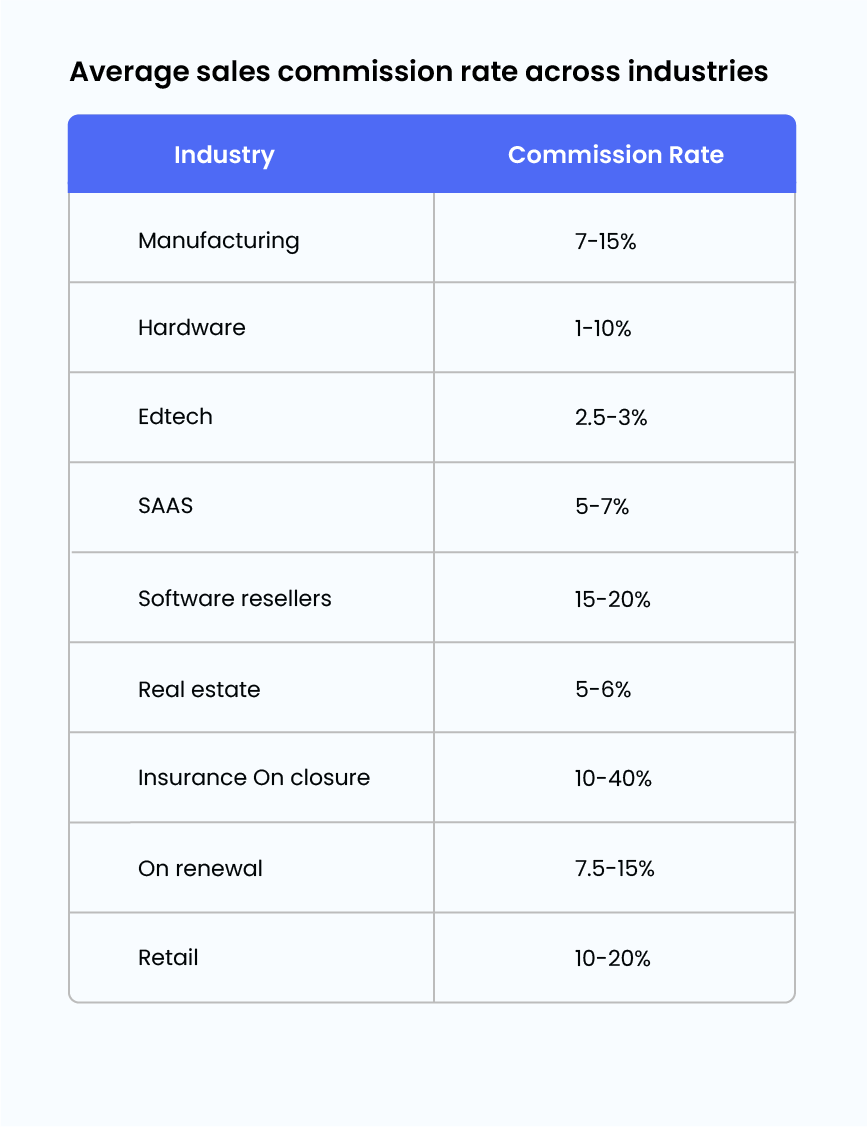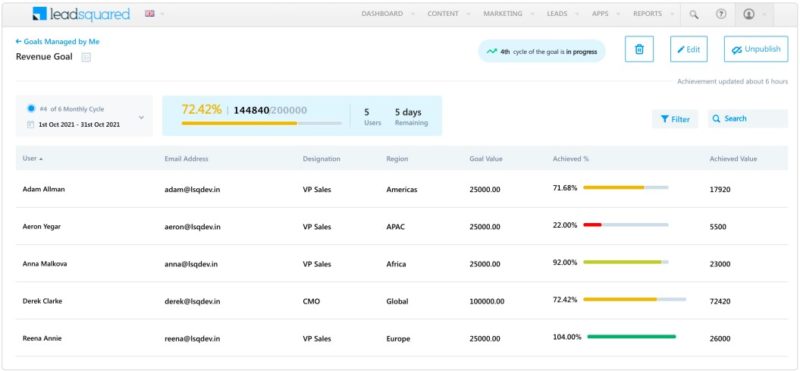Sales is a highly competitive domain.
Everyone has a high appetite for risk and wants to earn great rewards.
The reward we’re talking about here is sales commission.
When you increase the stakes and continuously reward your team’s efforts, the motivation follows on its own.
In this article, we’ve collected expert insights from sales leaders to help you choose a sales commission structure to keep your team’s morale high! The following sales experts took out the time to review our article for factual accuracy:
- Kaveri Shivkar, Chief Admission Head, upGrad
- Rahul Choudhary, Senior Manager, RiSE
- Venugopal Rajagopalan, Vice President – Business Development, LeadSquared
- Samay Rashmin Mehta, Senior Executive- Presales, LeadSquared
- Amit Singh, Manager-Partner Sales, LeadSquared
What is sales commission?
A sales commission is the compensation paid to a person based on the number of sales generated. Most salespeople receive their salary in two parts: the fixed and the variable component. This variable pay is usually the commission per sale.
The commission is entirely performance-based and dependent on how much of their targets they can meet. The higher the number of deals a salesperson closes, the higher their commission for that payment period.
Note, the sales commission rate varies according to the industry and type of employment. For instance, full-time sales employees earn commissions on top of their monthly salary (variable pay). Therefore, the sales commission % can be lower for them. On the other hand, agents and brokers make money only through commissions. So, the % commission can be higher for them.
Depending on the business, the variable pay can be in the form of incentives or commissions. But the terms are used interchangeably even though they are not the same. Let’s understand the difference between sales commission and incentives.
Sales commission vs. Incentives
Sales Commission | Incentives | |
Credited based on | Sales commission is a part of the salesperson’s paycheck. It is output oriented and depend on consistent performance. | Incentives are offered on top of the paychecks. They can be offered when a specific benchmark is met in terms of deals closed or revenue generated. |
Performance metrics | A commission is sanctioned on specific sales KPIs such as revenue generated, and deals closed. | Incentives are offered on a mix of KPIs and KRAs—maintain sales hygiene, build sales pipelines, create new sales contacts. |
Flexibility | Commissions are offered in a fixed structure and aren’t very flexible. | Incentives can be altered frequently, and these new benefits excite the sales team. |
Type of reward | It is solely a monetary reward that is added to the salesperson’s monthly paycheck. The sales team expects to receive this amount in their CTC. | They can be in the form of insurance for the family, team lunches, or vouchers. Incentives don’t have to be just monetary, and they can motivate the team in different ways. An example of such a scheme is SPIFF. |
Goal | Commissions ensure that long-term sales goals such as annual targets are achieved in time. | Incentives can be offered for a shorter time, such as closing ‘x’ number of deals within a week. |
Commissions or incentives can’t do the job of motivating your team individually. A good mix of these ensures that every team member, whether they are a high performer or low performer, stays motivated. Commissions can feel boring after a point of time if the structure chosen doesn’t suit your sales teams whereas setting incentives on easy-to-achieve targets aren’t profitable for the company.
So, how do you choose the best sales commission structure for your team? We’ll talk about it; but first, let’s look at the most popular ones.
7 Types of popular sales commission structures
Commission structures vary across industries and even within teams. The structure
you choose also needs to be profitable in the long run. The 7 most widely used sales commissions structures are:
- 100% Sales Commissions or Commission-only jobs
- Base + Sales Commission
- Tiered Sales Commission
- Gross Margin Sales Commission
- Residual Sales Commission
- Territory Volume Sales Commission
- Draw Commission
1. 100% Sales Commission or Commission-only jobs
In this structure, the salesperson’s entire paycheck is their commission. Their income is solely dependent on the outcome—the number of deals they close—and not on the activities that lead up to it.
Pros:
Since the commission percentage for such a structure is usually high, up to 30-40%, the salesperson has a higher motive to close deals faster. It increases your sales team’s accountability, and they don’t require any additional monitoring.
Cons:
With no fixed pay to fall back upon, this commission structure is exceptionally stressful for sales teams. The risk is high, and salespeople may mislead the client into purchasing a high-ticket size product just to earn an extra commission. The attrition here is high for both the customer and the sales team.
How to calculate 100% sales commission?
Based on the percentage of commission, the salesperson gains X% of the deal value. For example, for a 30% commission and deal value of $1000, the salesperson will receive $300.
Which businesses use the 100% sales commission structure?
- Fast-growing start-ups
- Real Estate business
- Products that have a well-structured sales cycle
- Non-customizable products
2. Base + Sales Commission
This structure works for most businesses. The commissions in this structure can be both capped and uncapped. Usually, the fixed to variable part in this structure falls under the range of 40:60 to 30:70. The commission percentage varies across different industries and roles.
Pros:
The salespeople have their fixed pays to fall back on during uncertain times. This safeguards the team member, and the commissions motivate them to perform better. It is also a competitive model that attracts the best talent. For the business, this structure ensures efficient payroll management. It encourages the sales team to cross-sell and upsell services.
Cons:
The capped commission structure restricts the salesperson’s activities, and they might not try to overachieve it. Your business can also face losses if underperformers don’t pick up the slack and continue to draw their fixed pay every month.
How to calculate base + sales commission?
If the salesperson has $500 as their base salary and completes a sale of $20,000 at 10% commission, their paycheck will be sanctioned for $2,500.

Which businesses use the base + sales commission structure?
- Most B2C setups such as Edtech or financial services
- Small and medium businesses
- Retail Outlets
3. Tiered Sales Commission
The tiered commission structure is dynamic, and the commission percentages change based on each tier. An outcome defines each tier. On meeting that benchmark, the salesperson moves to the next tier, where the commission percentage is higher.
Pros:
This structure is beneficial to the entire team—low, average, and high performers. The first tier is usually achieved by all, but the high performers are motivated to move towards the next slab. Salespeople will also aim for higher-value transactions and prioritize their prospects accordingly.
Cons:
In a certain period when deals are being closed faster, most of your team will be drawing commissions on higher slabs. This may affect your overall profitability. To adopt this structure, you need tools that track the salesperson’s progress and can calculate their monthly paychecks. A lack of a proper tool will lead to complicated payroll calculations.
How to calculate tiered sales commission?
Well-defined slabs are created, and a certain commission is assigned to each slab. For example, if a salesperson generates up to $10,000 in revenue, his commission percentage will be 5%. When he moves into the $10,000 to $20,000 bracket, the commission rate is bumped up to 8%.

Which businesses use the tiered sales commission structure?
- For well-established businesses that can afford higher commissions.
- Low ticket size and high-volume products
4. Gross Margin Sales Commission
The commission percentage set in this structure is applicable only on the gross margin instead of the entire deal price. The gross margin or the profit is the difference between the sales price and the product’s cost price. The commission percentage is applied to just the profit.
Pros:
It improves the business’ overall profitability and strengthens the bottom line. It ensures that the balance between profitability and targets achieved is maintained.
Cons:
The number of deals closed may decrease as the product pricing won’t be competitive with lower discounts. The sales cycle may become longer, and the negotiations become challenging for salespeople.
How to calculate gross margin commission?
After negotiations with the client, if the deal price is $1500 and the actual cost price is $800, the sales commission percentage applies to $700 instead of $1500. For a 10% commission rate, the salesperson gets [($1500-$800) x 10%] = $70 instead of $150 from a Base + Sales Commission structure.

Which businesses use gross margin sales commission structure?
- In any business where the salesperson has the option to offer a discount or is open to client negotiations.
- Car or Hardware Dealerships
- Wholesale distributors for SAAS or Software services
- B2B partner agencies
5. Residual Sales Commission
This structure benefits salespeople in the long term as a commission will be sanctioned with every renewal. The residual plan focuses on revenue from long-term relationships.
Pros:
In the long run, employees can earn a steady commission just from the ongoing accounts’ residual commission. Customer retention is high because the salespeople spend a significant amount of time building client relationships.
Cons:
The commission percentage is usually low. Each salesperson needs many accounts to receive a significant paycheck. Overall, paying the commission in one shot instead of regular intervals might be more profitable for a business.
How to calculate residual sales commission?
A sales commission percentage is finalized for each renewal.

Which businesses use the residual sales commission structure?
- Residual commissions work best for businesses with recurring payment periods.
- Insurance
- Advertising agencies
- Consultants
- Businesses with online subscription models
6. Territory Volume Sales Commission
In this structure, the total commission generated from a particular geographical location is divided between all the salespeople. This structure works for a team-based approach rather than individual contributors as the entire team benefits from a sale.
An alternative to this plan is setting a territory-specific commission, which would be higher for an untapped region. In regions where most accounts have been exhausted, the commissions can be decreased.
Pros:
The territory volume commission enables effective team building. It also helps businesses expand to new geos and scale faster in unexplored regions.
Cons:
As the logos increase in newer regions, the commission rates need to be reviewed and decreased once the market has been tapped. This negatively impacts sales performance and creates unhealthy competition within the team. While working as a team, each member receives the same commission, and overperformers find this structure unfair.
How to calculate territory volume sales commission?
If the total commission generated for a particular region is $8,000 and there are eight team members, each person receives $1000. For individual contributors, the percentage commission can be 10% for US teams and 8% for Middle East teams. The calculation remains the same as the Base + Commission Structure.
Which businesses use territory volume sales commission structure?
- Businesses planning to scale in new geos
- In a team-oriented sales team
7. Draw Commission
In this structure, a part of the commission is offered to the salesperson as a lump sum. The value that is assigned is the least commission that they can earn. If their actual commission exceeds this value, the salesperson receives the additional amount too. In some cases, the draw commission can be recoverable if the salesperson’s commission doesn’t exceed the lumpsum.
Pros:
The salesperson has a minimum expectation of his paycheck that includes the draw; whether he wants to exceed it or not depends on him. The lump sum in advance is an excellent motivator to deliver better results.
Cons:
The draw commission structure can lead to a complicated payroll calculation. In the recoverable model, salespeople must return the money they couldn’t achieve from the commission. This pressurizes the salespeople and also brings down their morale.
How to calculate draw commission?
Let’s assume that the draw offered in advance is $4000. If the salesperson achieves a commission of $5000, the additional $1000 will be credited to him. But if he fails to meet the $4000 mark and makes only $2000 in sales commission, he will return $2000 to the firm in the recoverable model. In an unrecoverable model, the company will not hold the salesperson accountable for this loss.
Which businesses use the draw commission structure?
- This structure works for a team that is new to sales. The added pressure ensures that the training for newcomers is practical.
- It can also prove to be effective for off-season products of uncertain sales periods.
he next section, we’ll discuss how an effective commission plan can help you in the long run.
Benefits of choosing the right sales commission structure
1. Better retention of sales talent:
Turnover in sales is pretty common. In fact, 45% of your sales team might be looking out for a new job in the next three months. Losing out on such a large chunk of sales talent can put a halt on your targets and slow down ongoing deals.
Seeking and onboarding new talent is tough, and it isn’t a profitable bet for your business. It can set you back by about 150-200% of each employee’s overall cost. The competition across sales roles in industries is extremely high, and to be the #1, every business wants the top salespeople on board.
The difference in commissions is a make-or-break factor here. The only way to decrease turnover is to provide compensation as per the industry standards. This ensures that your star performers continue to be a part of your team in the long run.
2. Higher sales productivity:
Commissions encourage salespeople to sell more. Each deal closed adds to their paycheck, and slowly, the salespeople align their personal targets—a new car or a new home—to the company’s targets.
Commission structures also help strike healthy competition within the team. As a result, your sales teams remain motivated and productive. Higher commissions reward the salesperson’s accountability and lead them to meet 100% of their targets, if not overachieve them.
3. Improve payroll management:
If salespeople had a fixed salary, an overachiever and an underperformer would earn the same. But commissions ensure that the payment follows results. This helps a business balance their revenue versus spending in terms of employee compensation.
But to achieve these benefits, you need to choose a sales commission structure that actually works for your business and helps your employees. Here’s how you do that:
Factors to consider while choosing a sales commission structure
One size doesn’t fit all when it comes to sales commissions. Your compensation structures need to be as unique as everyone in your sales team. While you can’t customize it individually, you can understand the team’s performance, potential, and previous track record to find a plan that works.
Analyzing the following factors will help you finalize the right sales commission structure:
1. Average Industry standard
The competition to onboard the best talent is fierce across all industries. The salespeople also want to feel valued for all the efforts they put in. It’s essential to look into the industry standards while setting benchmarks for sales comission. Here are the average sales commission benchmarks across different industries:
- Manufacturing: The agent’s commission rate is between 7-15%.
- Hardware: 1-10% commission percentage as the targets are volume-based.
- Edtech: 2.5-3% on every admission closed.
- SAAS-based: It begins at 5-7% but can go up to 30% based on the product and deal size.
- Software resellers: In this B2B model, the commissions range between 15-20%.
- Real estate: Typically, the commission is between 5-6%. It is split between the buyer’s and seller’s agents.
- Insurance: Insurance agents receive two commissions—on closure and on renewal. While the former ranges between 10-40%, the renewal commission falls between 7.5-15%.
- Retail: 10-20% of completed showroom sales.

2. Various roles in sales teams
“Sales commissions vary across different levels in sales teams. The salespeople earn commissions based on their targets. While managers and vertical heads earn a commission when the entire team hits a benchmark. At a higher level, the targets scale-up and commissions need to too.”
Kaveri Shivkar, Chief Admission Head, upGrad
Enabling your sales team is a tough job. Managers help their sales teams by providing the right resources, training, and support. Rewarding their efforts appropriately ensures that the team’s targets are continuously met.
3. Keep it simple
Renewing commission plans and adding new incentives can keep your sales teams excited. But it may also over-complicate things. The commission structure must be simple and easy to understand so they can calculate the output of their efforts themselves.
4. Type of Business
Businesses function in a lot of ways across various types of industries. Let’s divide the type of business into two broad categories, B2B and B2C, to understand the factors that determine sales commissions.
B2C
Choosing the suitable sales commission structure for B2C is dependent on the ticket size or the price point of your product. If the ticket size is very high, commissions are based on the number of deals closed instead of offering a percentage of the sale.
For low-value products or smaller deal size, a salesperson’s target is achieving higher volumes. Offering a commission per deal closed can motivate your sales team.
Businesses with many product offerings should also consider the complexity of their sales cycle while finalizing the commission rate.
B2B
B2B businesses, which include wholesale distributors and partners, operate differently.
“Unlike B2C, the commission percentage for a B2B partner is not fixed. It is calculated per deal based on the category of partner, predefined percentage, and the extent to which the partner adds value to your business.”
Venugopal Rajagopalan, Vice President – Business Development, LeadSquared
Usually, a range for the commission rate is set in place, for example, 15-20%. The amount is finalized based on the partner’s role and deal size. For example, there are three types of partners in a SAAS business—just referral, reseller, system integrator. Here, a system integrator receives the highest commission.
How to implement a sales commission plan?
Selecting a sales commission structure and rate is just the first step. The real effort goes into successfully implementing them. There are a few prerequisites to the same that you must keep in mind:
1. Optimize your sales process
Unless you want your salespeople fighting over every lead and deal closed, you need to set an SOP for all your sales processes. This begins right from lead distribution and tracking who contacted the client first.
Businesses with a large sales team cannot define these regulations and carry them out manually. But, using a lead management tool can help you set the process in place. You must define specific rules such as commission can be availed by only lead owners to avoid any confusion with the team.
2. Set definitive KPIs and KRAs
Commissions are target-based.
So, setting suitable targets requires you to take the following into account:
- Potential of the salesperson
- Account opportunity
- Customer base
- Opportunities to cross-sell and upsell
- Previous track account
- Sales funnel generated
Commissions are great motivators but keeping them target-based can make your teams lose sight of sales hygiene. Both KPIs and KRAs must be considered while deciding on commissions. The KRAs include maintaining sales pipelines and the number of potential deals. But for some teams, KPIs are motivation enough.
KPI tracking tools such as Tableau and CRMs make it easier to generate this data in one shot. LeadSquared’s target versus achievement feature helps businesses calculate commissions automatically. This calculation is based on the salesperson’s performance. Salespeople can also see their achievements right in front of them which is a great motivator.

3. Define the payment period
The payment period can be the same day as closure, a month, a quarter, or even yearly. It entirely depends on the sales cycle length and your policies related to sales attrition.
Calculating paychecks can be a task for the HR Ops teams if the KPIs aren’t tracked properly. The payment periods for incentives and commissions don’t have to align. Your sales reps just need to know when they’ll receive their rewards.
A business can also opt for a sales commission calculator tool that can be integrated with an existing CRM, ERP, or HRIS tool. This ensures error-free and on-time paychecks for your sales teams.
4. Create the Sales Commission Agreement
The sales commission agreement ensures that both the parties—partner and company for B2B, and employee and company for B2C—agree to the commission rate which has been decided. These agreements are usually a part of the salesperson’s offer letter while hiring. Whereas for a B2B partner, they can be drafted on a yearly or quarterly basis.
The important clauses in a sales commission agreement are:
- Contact information: Details of the individuals and organizations involved.
- Duties: Lay the exact expectation and targets for the employee or the partner. The commission will be extended if these targets are met.
- Commission structure: States the sales commission structure and commission rate.
- Term: The time during which this agreement stays valid. After this term is crossed, the agreement will expire and will require renewal.
- Non-disclosure: This clause ensures that confidential information is not shared with the competitors.
- Obligation: The task to be carried out by both parties. For example, granting commission to the partner or employee when the target is achieved.
- Governing law: Ensures proper jurisdiction to carry out the agreement.
- Acceptance: The individual and organization’s signature as agreement on all the clauses.
5. Analyze, Analyze, Analyze
Yes, this function is threefold. Before renewing a commission structure or setting up a new one, evaluate:
- How much of the target was met, overachieved, or not met?
- How did the previous compensation structure affect team productivity?
- Sales team’s feedback on the current compensation structure, including commissions and incentives.
“Innovative commission structures are more likely to increase your team’s enthusiasm towards closing deals.”
Samay Rashmin Mehta, Senior Executive- Presales, LeadSquared
Introducing new commission plans every quarter can be exciting and confusing for your teams. Here’s when you club them up with incentives. Identify the period where the sales commission structure isn’t enough to keep your team going and add new incentives to the mix.
To sum it up
Sales commissions are purely dynamic. The structure and rate you choose deliver results only in a specific time frame. As your business, product, and teams evolve, the compensation structures should also advance.
Landing on the right sales commission plan involves a lot of experimentation. So, go ahead and find what works for your teams. In our experience, compensation structures with various components of incentives and commissions—quarterly, ad Hoc target-based, and overachievement incentives—helps keep the team motivated. As long as the compensation structure is easy to understand and the targets are being tracked well, your team productivity will shoot up.
If you’re looking for a tool to manage all the sales activities and track target vs. achievement per individual and team, check out LeadSquared.
It has everything you need for managing leads, sales users, and deals.
FAQs
On average, the sales commission rate for B2C businesses is in the 20-30% range. While for B2B businesses, it lies around 7-15%.
To calculate their commission, salespeople need to multiply the commission rate by the sales revenue.
Sales Commission = Commission percentage * Sales revenue
For businesses that pay their salespeople a commission on every sales, the sales commission is accounted as an operated expense. But if your business charges a commission on the product or service, it’s a profit termed as commissions revenue.










